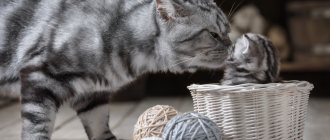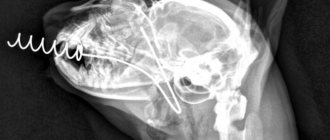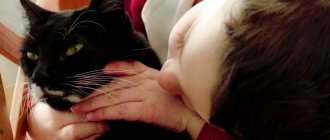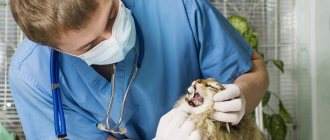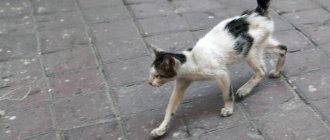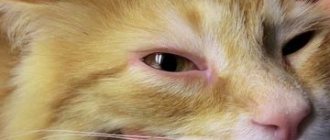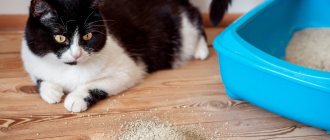What is the danger
Seeing the thread, the cat immediately remembers his childhood, the piece of paper on the thread and the fun of fussing with it. Therefore, not a single cat will pass by such an interesting item. At risk are young animals, kittens and pets left to their own devices for a long time. Young animals, due to lack of experience or for fun, can swallow a needle, thread, buttons, snaps and other small objects.
The structure of a cat's tongue. Furry pets, unfortunately, very often swallow sharp objects and, as a rule, this leads to their death. The problem is not that the cat is stupid and cannot “spit out” an inedible, dangerous object. The structure of a cat's tongue is such that a thread that gets into the mouth can only be swallowed.
The tongue has hard tubercles directed towards the esophagus. As it turned out, the tips of the tubercles have a U-shaped structure. With this “fork” the animal rips meat off the bones of its prey and takes care of its coat. A pet can only swallow a thread caught in these “flyers”, otherwise it is impossible to get rid of it. And along with the thread, the needle is sent into the esophagus.
Consequences and risks
The needle can pierce the stomach, intestines and damage other organs adjacent to them, or penetrate muscle tissue. Various options for passing a sharp object are fraught with:
- perforation of the digestive tract;
- development of erosion, ulcers, neoplasms;
- tissue necrosis;
- internal bleeding;
- peritonitis;
- mucosal injury followed by inflammation;
- dehydration as a result of vomiting and diarrhea;
- exhaustion due to refusal of food, intestinal obstruction;
- damage to internal organs.
Even if the needle is very “successfully” located in the body and does not cause any disturbance to the animal, after a while it will begin to oxidize under the influence of biological fluids and digestive juices.
Metal oxides can cause purulent melting of tissues and blood poisoning.
Signs of internal damage
If a cat swallows a sewing needle, it may exhibit symptoms characteristic of gastrointestinal injuries:
- loud meowing and rubbing of the face;
- apathy, lying motionless in one place;
- refusal of food and water;
- profuse drooling;
- nausea and vomiting, possibly with traces of blood;
- hiccups or belching;
- bloody streaks in the stool;
- constipation, flatulence, bloating.
If the needle is stuck in the throat, palate or esophagus, the cat strains its neck, often swallows, coughs, and wheezes. Don't worry if your cat behaves normally, doesn't show anxiety, and there are no signs of damage.
What to do if your cat ate a crocus?
Eating indoor and garden plants and the owner's bouquets is one of the cat's favorite pastimes. And, unfortunately, it is quite risky, since many potted and cut flowers are poisonous to animals.
The most dangerous for cats are all bulbous plants (tulips, crocuses, irises, lilies), all euphorbias, crushed seeds of some rosaceous plants (apricot, plum, apple, peach, etc.), as well as aloe, kalanchoe, monstera, aconite, delphinium and many others. Bulbous plants poison even the water in which they stand, so most often tragic cat poisonings are associated with them.
If you see that your cat is chewing any indoor, garden or bouquet plant, urgently check the lists of poisonous vegetation, and if you find yours there, immediately run to the veterinarian. In most cases, the count is in minutes and hours.
To avoid this, isolate bouquets from the cat, and distribute all dangerous indoor plants to friends.
Helping an injured pet
If such a dangerous “trouble” does happen to a mustachioed tabby, then the owner should not waste time in the hope that everything will work out and the needle will leave the body with the feces. The fact is that food that enters the animal’s gastrointestinal tract passes through the tract in 12-24 hours. And the intestines are “folded” into loops, and sooner or later the needle will get stuck somewhere.
According to statistics, only in 2% of cases an object is independently “evacuated” from the body without serious injury or damage.
Therefore, the owner will have to take a number of urgent measures.
What to do to save your pet
As soon as the owner discovers that sewing supplies are missing or suspects that the cat has swallowed threads or needles, it is necessary:
- contact a veterinarian and call him to your home;
- help organize transportation of the pet to the veterinary clinic.
If the doctor cannot come to the call, then you need to carefully place the cat in a carrier, calm it down and calm down yourself, and urgently go to the veterinary clinic.
What not to do
While waiting for a doctor, you should never:
- palpate, knead, tap the pet’s belly and sides;
- sharply lift, turn over, shake the cat;
- try to induce vomiting or stimulate bowel movements;
- give food and water until the doctor's visit;
- try to remove the needle yourself using tweezers or the tip of a thread.
To take risks or not. You can often hear how, with the help of petroleum jelly and plenty of soft food, the owners managed to reduce the risk of intestinal damage and wait until the needle comes out naturally. Distrustful owners of furry pets should analyze the relevant chats, reviews and make sure that there are much fewer stories with a “happy ending” than tragic ones. You need to entrust the life and health of your pet to professionals, and not play Russian roulette.
Also watch the video on what to do if a kitten ate a needle, thread, or bag:
Removal by operation
From the intestines
When intestinal obstruction is confirmed by radiographic and ultrasound methods, the surgeon, as a rule, decides to perform diagnostic laparoscopy. During the operation, the foreign body is removed and the intussusception is reduced. If necessary (in cases of necrosis), part of the intestine is resected.
To learn how to remove a foreign object from a cat’s intestines using enterotomy, watch this video:
From the stomach
In rare cases, it is possible to remove a foreign object from the stomach using diagnostic gastroscopy. If a foreign body is detected in the stomach of a domestic cat using endoscopic, x-ray or ultrasound examination, the surgeon usually decides to perform a gastrotomy.
Removal of threads from the stomach during gastrotomy
Having gained immediate access, the stomach is held in place using ligatures. The foreign body is removed using instruments or palpation. After suturing the mucous membrane and muscle layers, the organ is returned to its anatomical location. The operation is performed under general anesthesia.
From the esophagus
If the location of the foreign body is the esophagus, in some situations it is possible to remove it using an endoscope. If the object is large, the surgeon can perform an esophagotomy. The operation is indicated if the x-ray shows perforation of the walls of the esophagus, or the foreign body is large and has sharp edges.
Often the veterinarian resorts to the following manipulation. Using an endoscope, an object is pushed into the stomach, after which the animal undergoes a gastrotomy, followed by removal of the foreign body.
Penetration of a foreign body into the digestive canal of a pet is a dangerous phenomenon for health and life. The animal must be urgently taken to a specialized facility for special diagnostic procedures to visualize the swallowed item. As a rule, treatment comes down to surgical removal of the foreign body by laparoscopy, gastrotomy or esophagotomy, depending on its location.
I never thought that such a “halepa” could happen to me and my animal. The cat Fasya, with her stupid habit of eating everything that is in place or out of place, always alarmed me with this stupidity of hers. In the house they eat: buttons (if they came off the clothes and were not removed in time), pieces of cotton wool, foil, flowers, fabric and, most importantly, threads, we try to hide it all, but the cat miraculously finds all our hiding places. Threads are the biggest passion of an abnormal cat! Please note that we feed the cat well, with premium food, which costs 2 or even 3 times more than the notorious Whiskas. There is another feline living in the house; such extravagances have NEVER been observed before him! Therefore, it makes sense to say that this is simply an individual behavioral trait of one particular animal, and not desperate attempts to show the owners that the cat is dying of hunger. Yes, I’m a fool, I was pulled by the devil, confused by the demon, blown away. I left the unfinished sewing on the table overnight. Either she was tired and didn’t think of it, or God knows. In general, the result is this: my husband wakes me up in the morning and says that Fasya was sitting on the table and dancing, she probably found a thread. At first I didn’t pay any attention to it; when I was asleep, everything didn’t seem so scary, but only then did it dawn on me that in addition to the box of thread, there was sewing on the table and a thread and needle stuck into the fabric. Upon examination, it turned out that the thread was bitten and the needle was missing. My husband also suggested whether the cat could have eaten all this stuff? I didn’t want to think about it... The needle was huge, about 5 centimeters. When I realized everything, my first thought was to look for the corpse of a cat in the apartment, which, having devoured such a thing, could already give its soul to God twice. The cat was found, quite healthy and even cheerful. Then hope began to swell within me: what if she simply bit through the thread and thought of spitting out the needle somewhere. The entire apartment was searched for 20 minutes with a flashlight and a magnet. There was no needle anywhere... There was only one way out. I ran with this sword eater for an x-ray. After the first photograph, an oil painting was revealed: the needle was safely lying in the animal’s stomach. I would like to note that as soon as I began to suspect that the cat had breakfast with a needle and thread, I gave it Vaseline oil. As it turned out, she did absolutely the right thing. Vaseline oil lubricates the walls of the stomach and intestines and is not absorbed into the blood. At the same time, in a lubricated stomach, it is more difficult for a needle to stick into the walls, because it is slippery. As soon as the needle was discovered, the veterinarian, who turned out to be a former military doctor, advised me not to worry, give the cat a piece of cotton wool with Vaseline oil and wait. The needle MAY come out on its own. Yeah, the main word here is CAN, but what if it can’t? A 5-centimeter piece of crap will safely pass through the intestines and appear to me accompanied by cat shit?! I seriously doubt it... I called a veterinarian I know, she, of course, said that there is such an option, but if the needle sticks into the heart or pulmonary artery, then We won’t even have time to take the animal to the clinic. The option to wait is for those who are not very worried and do not particularly value their pet. Indeed, it happens that sharp objects come out on their own, but more often they don’t. We decided to operate. I would like to say that this is not the first time that veterinarian Polina Lutsenko and the doctors at the Polivet clinic have helped me out promptly, efficiently and inexpensively. This rarely happens these days. So that the price/quality ratio is at its best. I will not now describe the reasons why I already asked for help, but animal owners should understand me perfectly; no one can predict what your pet will do next moment, not even those owners who take almost perfect care of their animals. Within 2 hours, the cat was operated on, the needle was safely removed, and the cat, having stuck out its tongue, lay in anesthesia under a drip. I cried like a fool. I couldn’t forgive myself for my carelessness - how could I almost kill the cat?! But they still brought me to my senses. This could happen to anyone, no one is immune from this! As it turns out, cats eat needles with enviable regularity. Everything is explained very simply - the cat plays with the thread, the thread clings to the rough tongue, the cat cannot take and remove the thread from the tongue, so it simply takes and swallows everything whole. Most often, the needle falls into the cat's stomach with the non-sharp part, this, for the most part, saved my cat. She didn't realize what happened. The needle did not have time to stick in and cause discomfort. Therefore, for the red-haired fool, this whole procedure resembled an execution: everything was fine, they took it, carried it somewhere, pricked it, cut it... Koshak was seriously offended. Now this circus performer will be on a diet for 2 weeks! Broths, porridges, low-fat kefir - that’s the whole diet. But everything ended well! I advise those animal owners to whom, God forbid, this has happened, to immediately give the cat some Vaseline oil and take it for an x-ray. Don’t look for a needle in the apartment - if it doesn’t lie within 2-3 meters from the place where it originally lay, then by spending time searching you will take it away from the cat, for which this delay can be fatal. The operation is expensive. I warn you right away. But you can earn money, but no one will return the animal to you! Therefore, do not blame yourself, what happened happened, it is important to correct this situation as soon as possible. Now my cat is already recovering. She, of course, does not like the blanket she is wearing, so as not to lick the seams. He even eats the hated porridge, because hunger is not a problem). Even the swelling went away. Now she lies on my feet and purrs quietly! Now she has a new nickname - Fasya the circus performer.
The cat ate a thread, what to do to help the animal. Cats are very curious animals and it’s a nice thing to feast on thread, rope, and New Year’s rain. Cats do not understand all the risks associated with this gastronomic sketch, but there is certainly a risk. A foreign, non-food product that gets into a cat’s esophagus is an extremely undesirable guest in your furry pet’s body.
Diagnosis and treatment
At the veterinary clinic, the doctor will prescribe and conduct an instrumental examination, including:
- X-ray – the image will immediately show how and where the needle is located. To identify the thread, an X-ray examination with a contrast agent is performed.
- Ultrasound - an ultrasound examination will allow a specialist to assess the condition of organs adjacent to the gastrointestinal tract that could be injured by a needle.
- Gastroscopy – using a gastroscope, the doctor will examine the digestive system and assess the damage caused by the needle as it passes.
Blood and urine tests are prescribed less frequently - if abdominal surgery is necessary and after removal of a sharp object.
Surgical treatment
In order to remove the needle, the following is prescribed:
- abdominal surgery, when the animal is opened and, after removal, sutured;
- endoscopic intervention - the operation is performed laparoscopically - through small punctures that do not require sutures and long-term rehabilitation.
Surgical techniques. Depending on the location of the needle, different surgical techniques are used, namely:
- enterotomy – from the intestines;
- gastrotomy - from the stomach;
- esophagotomy - from the esophagus.
After the operation, the animal remains in the clinic for some time under the supervision of a doctor.
Symptoms in a cat
Ingestion of a foreign object does not always occur before the eyes of the owner. The discovery of the loss of one or another item in the room and the inadequate condition of the cat should cause alarm among household members and force them to take a closer look at the presence of the following symptoms in the pet:
- When an inedible object gets stuck in the esophagus, severe salivation is observed.
- When an object is localized in the pharynx, the cat coughs, wheezes, and may experience cyanosis of the tongue and loss of consciousness.
- The animal is anxious, stretches its neck, and makes frequent swallowing movements.
- Constant vomiting, belching. The duration of vomiting can last from several hours to several days, depending on the severity of the damage to the digestive canal and the location of the object.
- Complete lack of appetite, the animal refuses even its favorite treat.
- Pain in the abdomen, accumulation of gases, bloating.
- Lethargic and apathetic state, drowsiness.
- Stool retention, diarrhea, constipation.
- Reducing the amount of feces.
- With chronic obstruction, cachexia develops due to decreased appetite.
- Signs of general intoxication of the body.
Bearing in mind the danger of foreign bodies entering the gastrointestinal tract of a domestic cat, the owner should immediately take the animal to a specialized clinic.
What to do if a cat ate a thread?
Any inedible object eaten by a cat threatens it with two dangers - intestinal obstruction and perforation. If a cat has eaten a non-sharp, small and/or biodegradable object (a piece of paper, a raw bone, a fruit seed, a coin, a button, a cotton swab, etc.), then most likely it will come out on its own naturally. In this case, you can give petroleum jelly or a mild laxative (which does not increase intestinal motility), but only if you are absolutely sure of the relatively safe characteristics of what you swallow.
